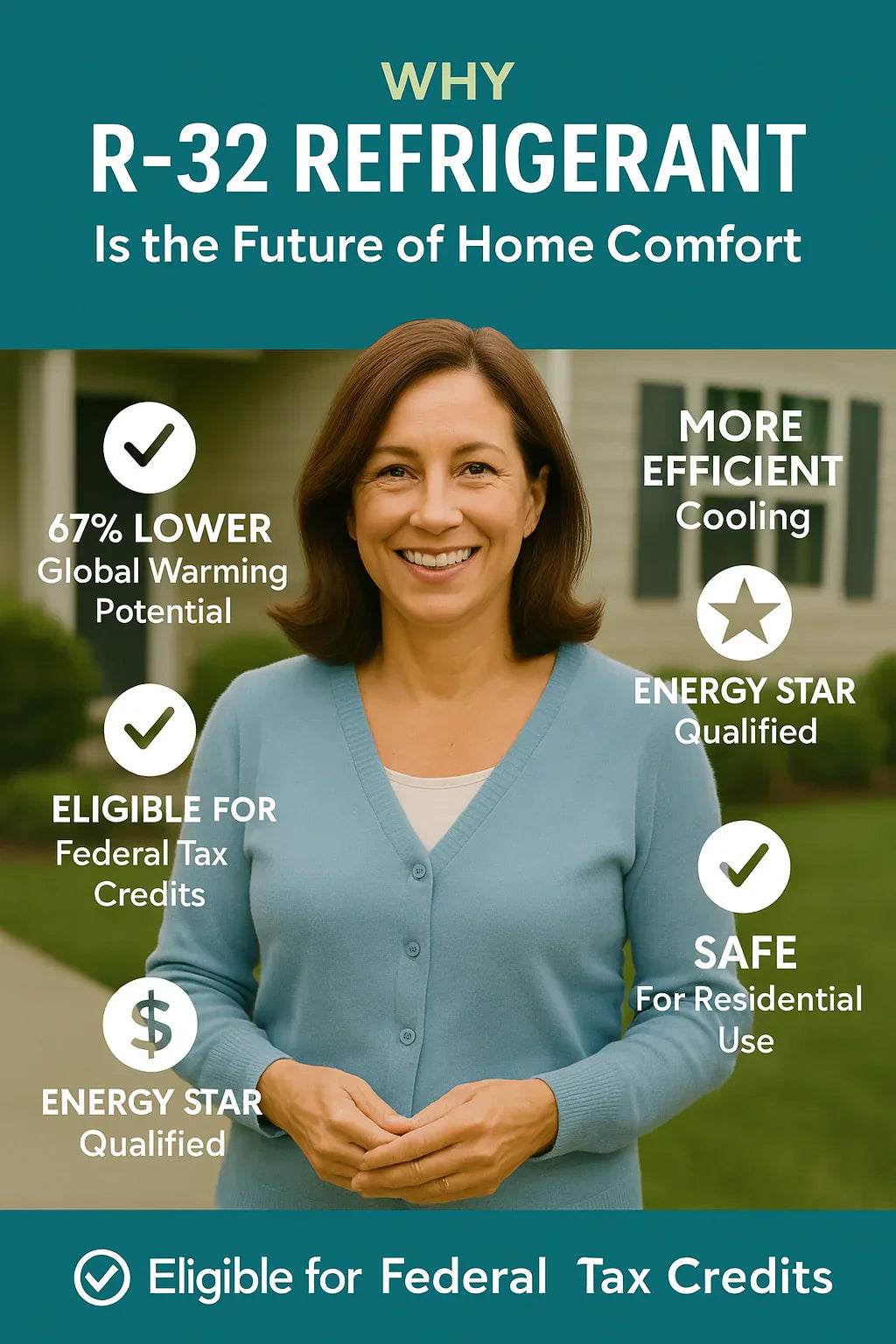When shopping for a new air conditioner or gas furnace combo, you might notice the growing buzz around R-32 refrigerant. Marketed as a next-generation alternative to R-410A, R-32 promises lower environmental impact, better energy efficiency, and future-proof compliance with environmental regulations. But is it really greener — and more importantly, is it the right choice for your home?
This guide will walk you through what R-32 refrigerant is, how it compares to legacy options, what it means for safety and performance, and what to ask your HVAC installer before committing.
🌍 What Is R-32 Refrigerant?
R-32, also known as difluoromethane, is a single-component hydrofluorocarbon (HFC) used in residential and commercial air conditioning systems. It has a lower Global Warming Potential (GWP) than R-410A and has been widely adopted in Europe and Asia as part of the movement to reduce climate impacts from refrigerants.
-
Chemical formula: CH2F2
-
ASHRAE designation: A2L (low toxicity, mildly flammable)
-
GWP: 675 (compared to R-410A's 2,088)
👉 Learn more about refrigerant classifications from ASHRAE
♻️ How Does R-32 Compare to R-410A Environmentally?
One of the biggest reasons R-32 is gaining traction is its environmental profile. Let’s compare it with the current standard refrigerant, R-410A:
| Criteria | R-32 | R-410A |
|---|---|---|
| GWP | 675 | 2,088 |
| Ozone Depletion Potential | 0 | 0 |
| Flammability | Mild (A2L) | Non-flammable (A1) |
| Efficiency | Higher | Standard |
Because of its lower GWP, R-32 helps manufacturers and homeowners meet U.S. Environmental Protection Agency (EPA) and global Kigali Amendment goals.
👉 EPA: Understanding Global Warming Potentials
🔒 Is R-32 Safe for Residential Use?
R-32 is classified as A2L under ASHRAE Standard 34, which means it is:
-
Low toxicity
-
Mildly flammable, not explosive
Compared to natural gas appliances, the flammability risk is minimal. However, proper ventilation and adherence to manufacturer instructions are critical. Most modern R-32 systems are designed with safety sensors, leak detection, and pressure regulators.
Key precautions include:
-
Not using R-32 in enclosed, poorly ventilated spaces
-
Only using certified HVAC technicians for installation
👉 UL Safety Standards for A2L Refrigerants
⚡ How Energy Efficient Is R-32?
R-32 enables more efficient heat exchange, allowing units to use less refrigerant volume while achieving the same or better cooling and heating performance. In fact, many systems using R-32 achieve:
-
Higher SEER2 and HSPF2 ratings
-
Lower compressor power consumption
-
Reduced carbon emissions over time
This translates to lower utility bills and improved performance, especially in high-heat regions.
👉 Department of Energy: SEER2 Standards
🛠️ Can I Retrofit My Existing HVAC System to Use R-32?
No — R-32 is not a drop-in replacement for R-410A systems. Here’s why:
-
Different pressure levels require R-32-compatible compressors
-
Lubricant incompatibility between R-32 and R-410A systems
-
Line set differences and equipment design changes
Retrofitting would likely cost as much (or more) than installing a new system. It’s recommended to install a purpose-built R-32 system.
👉 AHRI Guidelines on R-32 Compatibility
🧰 What Maintenance Does R-32 Require?
In general, maintenance for R-32 systems is similar to that of R-410A, but with a few considerations:
-
Leak detection: Use electronic sensors designed for A2L refrigerants
-
Filter changes: Follow manufacturer instructions to prevent coil freezing
-
Annual inspections: Ensure there are no pressure issues or improper storage
-
Technician training: Only hire HVAC pros certified to handle A2L refrigerants
👉 HVAC Excellence Technician Certification
🧾 Are There Rebates or Incentives for Using R-32 Systems?
Yes — many R-32 systems meet ENERGY STAR requirements and qualify for federal and local incentives:
-
Federal 25C tax credits for up to $2,000
-
State-level energy rebates through programs like Mass Save or Efficiency Vermont
-
Utility incentives for high-SEER installations
Check eligibility with your installer and verify model numbers against government databases.
👉 ENERGY STAR Qualified Products
👉 DSIRE: Database of State Incentives for Renewables & Efficiency
🏡 Is R-32 Right for Your Home?
Consider choosing R-32 if:
-
You're building new or replacing an older R-410A unit
-
You want a future-ready system compliant with refrigerant phaseouts
-
You’re seeking lower emissions and energy bills
Avoid R-32 if:
-
You’re trying to retrofit an older system
-
You have safety concerns about flammability (e.g., small enclosed install space)
✅ Final Takeaways
R-32 refrigerant is a greener, more efficient solution for modern homeowners. While it’s not suitable for retrofits and does require A2L safety considerations, it delivers impressive performance with a reduced climate footprint.
If you’re shopping for an HVAC upgrade, a 2.5-ton R-32 AC and gas furnace system offers a balanced, forward-thinking solution — especially when paired with ENERGY STAR ratings and smart thermostats.
Have questions about whether R-32 is right for your home? Consult a certified installer or explore R-32-ready systems at The Furnace Outlet.
In the next topic we will kow more about: How Big Is 2.5 Tons of Cooling Power? Understanding HVAC Sizing







